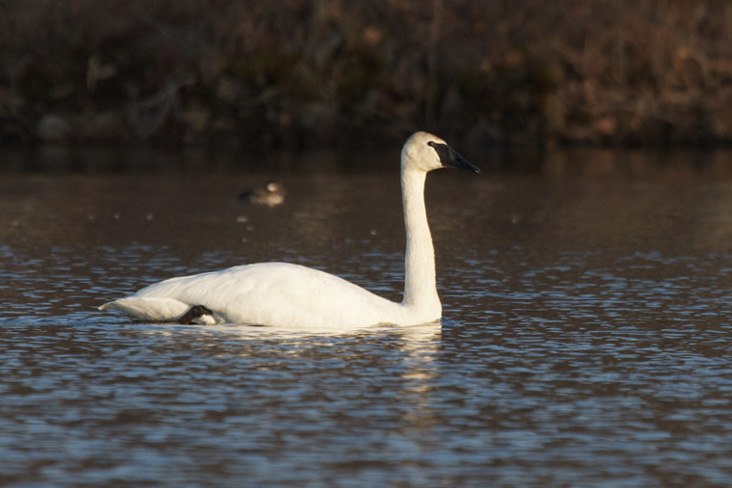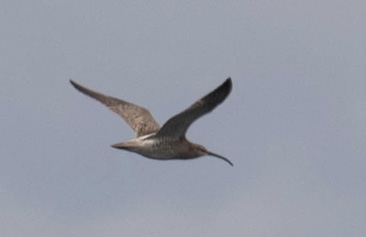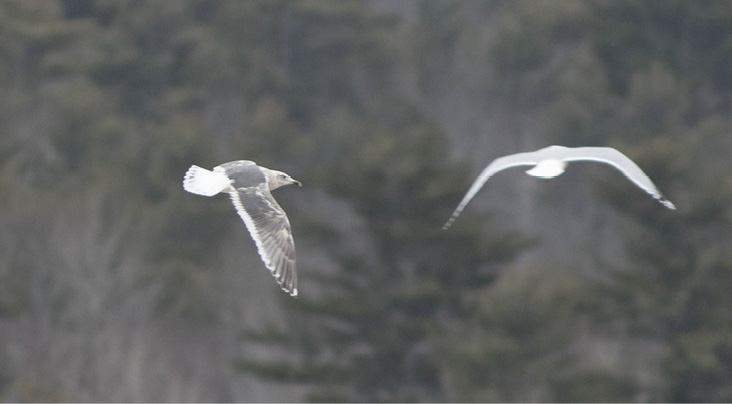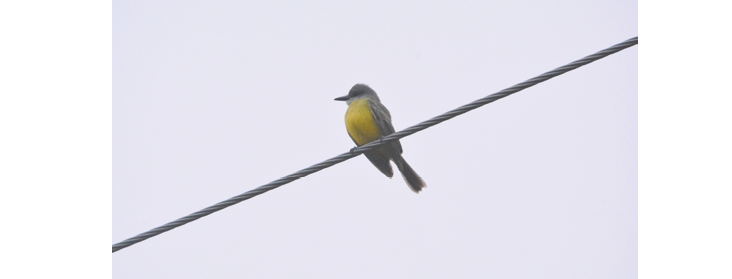Douglas P. Hitchcox, Tom Aversa, Louis R. Bevier, and Trevor B. Persons

Trumpeter Swan was added to Maine's list after questionable provenance delayed review of one found in Biddeford from April 8–15, 2011. Photograph by Doug Hitchcox.
The Ninth report of the Maine Bird Records Committee (hereafter ME-BRC or the committee) summarizes the assessment of 70 reports involving 36 species or species pairs. Evaluation of and decisions by the committee for these reports occurred during 2019. The committee accepted 50 records for an acceptance rate of 71%. Although the majority of birds in this report were documented in 2018–2019, the years of occurrences ranged from 1973 to 2019.
Highlights in this report include Maine's first record of Zone-tailed Hawk. In addition, the first state record of Trumpeter Swan, previously unreviewed, is accepted here. These bring the total number of documented species on Maine's state list to 464. The official list of bird species recorded in Maine, our review procedures, and list of members can be found at the committee's website: http://sites.google.com/site/mainebirdrecordscommittee.
Records in this report are grouped by species, with both those accepted and those not accepted listed within the same species account. Each account provides the location, county (italicized), dates of occurrence, names of observers or contributors, and committee record number. Documentation was provided by the observers listed or, in some cases, was obtained from public websites. All reviewed materials and member comments are archived. If known, the names of finders are listed first and separated from other names by a semicolon. Photographic, video, or audio evidence reviewed is denoted by a dagger (†); written notes are denoted by an asterisk (*). As always, the committee strongly encourages written submissions even when there are photographs. Species accounts follow the current taxonomic classification and sequence adopted as of 2019 by the American Ornithological Society (list available at http://checklist.aou.org/taxa/.
Species Accounts
Pink-footed Goose (Anser brachyrhynchus). This species is now nearly annual in Maine. A bird photographed at Lake Josephine, Aroostook, October 5, 2018, (Bill Sheehan†; 2018-037) represents the state's eleventh accepted record since the first in 2009.
Barnacle Goose (Branta leucopsis). A group of three were at Lake Josephine and Christina Reservoir, Aroostook, October 10 and 12, 2017 (Richard Garrigus†, Bill Sheehan†; 2017-040).
Cackling Goose (minima) (Branta hutchinsii minima). NOT ACCEPTED, ORIGIN UNCERTAIN: A bird showing characters of B. h. minima, normally found only along the Pacific Coast, was at Kennebunkport, York, August 11, 2017 (2017-034). As suspected by the observer at the time, this bird was likely an escapee, a fact later confirmed when photos of captive birds on a farm in close proximity were discovered by the committee.
Trumpeter Swan (Cygnus buccinator). Representing the first accepted state record, this swan was found in Biddeford, York, April 8–15, 2011, but was not initially reviewed because of questions of origin (Nancy McCreel*; David Doubleday*, Peter Morelli*, Andrew Aldrich†, Christopher Bartlett†, Doug Hitchcox†, Chuck Holmer†, Marie Jordan†, Derek Lovtich†; 2011-016). Likely originating from introduced populations around the Great Lakes, either those actively reintroduced in southern Ontario since 1982 (Carroll and Swift 2000) or progeny of escaped captives in western New York that first started breeding there in 1995 (Sherony and Bolsinger 2007), a pattern of occurrence in the Northeast is now well established. New York, Connecticut, Vermont, and Massachusetts all have accepted the species in recent years. The Biddeford bird had a damaged and withered left eye, which allowed it to be tracked on its wanderings from Maine to Prince Edward Island in May and then to western Quebec in June 2011.
Tundra Swan (Cygnus columbianus). First found at Scarborough Marsh, Cumberland, March 18, 2019, (Brad Woodward†, Tom Foley; Kevin Couture†, Josh Fecteau†; 2019-002) this bird was possibly (but not unanimously agreed upon by the committee) the same as one seen in Arundel from March 25 to April 1, 2019, and later in Lyman, York, April 5–6, 2019 (Nate Jones; Nate Hall†, Andrew Aldrich†, Gary Jarvis†; 2019-004).
Western Grebe (Aechmophorus occidentalis). One bird was photographed off Cape Elizabeth, Cumberland, January 20, 2017 (Richard Garrigus†; 2017-002).
Eurasian Collared-Dove (Streptopelia decaocto). Representing a second accepted record for the state, a singing bird lingered at Monhegan Island, Lincoln, May 27 to June 23, 2019 (Noah Gibb; Jeremiah Trimble†, Kristen Lindquist*; 2019-021). NOT ACCEPTED, IDENTIFICATION QUESTIONED: A report of a bird on power lines in Leeds, Androscoggin, lacked sufficient detail to rule out other Streptopelia species (2018-017).
Chuck-will's-widow (Antrostomus carolinensis). At least one singing bird was present and audio recorded at the Great Pond Mountain Wildlands in Orland, Hancock, June 6–30, 2018 (Cheri Domini; Doug Hitchcox†, Trevor Persons†; 2018-015). The latter observer reported two structurally similar, large, long-winged nightjars flying in tandem five feet over his head and thought that the presence of a second bird indicated a territorial pair, and thus likely breeding. Quiet grunting calls, persistent singing, and a bird returning in 2019 to the same location for over a month (presently unreviewed) all support this probability. The same observer also audio recorded another Chuck-will's-widow at Wells, York, July 2, 2018 (Trevor Persons†; 2018-018). Only one previous record has been reviewed and accepted by the committee, but reports date back to at least 1974. NOT ACCEPTED, IDENTIFICATION QUESTIONED: Reports of birds briefly heard at Indian Township, Washington, July 13, 2012 (2012-022) and at Cutler, Washington, July 16, 2013, (2013-023) did not include detailed descriptions or audio recordings.
Rufous/Allen's Hummingbird (Selasphorus rufus/sasin). An immature male from Deer Isle, Hancock, September 16, 2019, (Bonnie Bochan*; Paul Miller†; 2019-040) could not be identified to species and was accepted by the committee under this species pair.
Wilson's Plover (Charadrius wilsonia). Two reports of this species were accepted, one from Ram Island, Cumberland, May 15, 2018, (Zac Fait†, Heidi Franklin; 2018-009) and another from Seal Island National Wildlife Refuge, Knox, July 13, 2019 (Keenan Yakola†; 2019-032).

Field marks are consistent with European Whimbrel, found in Frenchboro, May 29, 2019. Photograph by Alex Lamoreaux.
Whimbrel (European) (Numenius phaeopus phaeopus). A bird photographed in flight at Frenchboro, Hancock, May 21, 2019, showed characters of European Whimbrel, i.e., the widespread nominate subspecies N. p. phaeopus plus Iceland-breeding N. p. islandicus and the recently-described central Siberian-breeding N. p. rogachevae (Allport 2017), and represents a first for Maine (Alex Lamoreaux†; 2019-024). The Frenchboro bird had an all-white, unbarred lower back and rump like all European breeders (i.e., subspecies alboaxillaris and phaeopus/islandicus/rogachevae), and unlike North American-breeding N. p. hudsonicus and N. p. variegatus. Also, it showed some barring on the underwings and axillaries, which are pure white in alboaxillaris (Allport 2017).
Long-tailed Jaeger (Stercorarius longicaudus). Four reports were accepted: An immature off Bar Harbor, Hancock, July 31, 2013 (Gary Leavens†; 2013-024); an adult north of Seal Island National Wildlife Refuge, Knox, July 11, 2019 (John Drury†; 2019-047); an adult at Seal Island National Wildlife Refuge, Knox, August 18, 2019 (Zeke Smith, Keenan Yakola†; 2019-036); and two immatures at Mount Desert Rock, Hancock, August 9, 2019 (Nathan Dubrow†; 2019-035). Fourteen reports of this species have now been accepted by the committee, all since 2008. NOT ACCEPTED, IDENTIFICATION QUESTIONED: A report of a light-morph adult from the CAT ferry from Portland to Nova Scotia, September 12, 2016 (2016-035) did not indisputably rule out Parasitic Jaeger and also left doubt as to the exact location of the sighting. A report from Mt. Desert Rock, Hancock, August 28, 2018 (2018-032) did not provide diagnostic evidence adequate to rule out other jaegers. The committee discussed halting review for this species but decided to continue due to the difficulty in separating jaeger species.
Mew Gull (Larus canus). Apparently returning from 2016, a bird identified as of the western North American brachyrhynchus subspecies was present at Owls Head Harbor, Knox, January 28 to February 5, 2017 (Keenan Yakola†; 2017-003).

A Slaty-backed Gull, Maine's second, was found in Augusta on February 23–24, 2018. Photograph by Doug Hitchcox.
Slaty-backed Gull (Larus schistisagus). A third-cycle bird, representing a second state record, was photographed at Hatch Hill Landfill, Augusta, Kennebec, February 23–24, 2018 (Doug Hitchcox†; Louis Bevier†; 2018-003). This individual was found earlier at Cambridge (February 16) and Gloucester (February 19), Massachusetts (Williams and Trimble 2018), a reversal of the pattern of Maine's first Slaty-backed Gull (also a third-cycle bird), which was documented in Gloucester eight days after last being seen at the same landfill in Augusta on January 13, 2012 (Persons et al. 2015).
Gull-billed Tern (Gelochelidon nilotica). Two individuals of this uncommon tern arrived in Maine thanks to Hurricane Dorian, the first found at Popham Beach State Park, Sagadahoc, September 11, 2019 (Mike Fahay†; 2019-046) and the second at Biddeford, York, September 28, 2019 (Gary Jarvis†, Leon Mooney*; 2019-042).
Red-billed Tropicbird (Phaethon aethereus). Maine's celebrity Red-billed Tropicbird returned for its 15th consecutive year in 2019, staying from May 7 through August 16, 2019, at the seabird nesting colonies at Seal Island National Wildlife Refuge, Knox (Keenan Yakola†; 2019-014).
Pacific Loon (Gavia pacifica). A well-described alternate-plumaged Pacific Loon flew by Monhegan Island, Lincoln, October 1, 2018 (Jeremiah Trimble*, Ryan Doherty; 2018-038), and a basic-plumaged one was photographed off Schoodic Point, Hancock, November 11, 2018 (Kyle Lima†; 2018-045).
Barolo Shearwater (Puffinus baroli). NOT ACCEPTED, IDENTIFICATION QUESTIONED: An intriguing report of a bird seen from a cruise ship ~155 km SSE of Mount Desert Island on October 30, 2019, (2019-051) did not contain enough unambiguous detail for acceptance, especially for a potential first state record. In addition, many members were uncomfortable with the location of the sighting within the Gulf of Maine, far west of the edge of the Continental Shelf where most other documented sightings have occurred (http://www.ebird.org. Accessed: January 25, 2020).
Magnificent Frigatebird (Fregata magnificens). NOT ACCEPTED, IDENTIFICATION QUESTIONED: A report of a bird seen at Bar Harbor, Hancock, August 5, 2005 (2005-009) contained too few details to eliminate other species, especially other species of frigatebirds. Intriguing, however, was the report of a Magnificent Frigatebird in Chatham, Massachusetts, only two weeks earlier (Rines 2006).
Brown Booby (Sula leucogaster). Reports of this species extended farther northward into the Gulf of Maine during 2018 and 2019 than in previous years as Maine mirrored the extraordinary climate-driven change in status seen farther south. Maine's first state records weren't reported until 2011, 2013, and 2017, and the committee more than doubled the number of accepted records by endorsing four additional reports. An immature showed nicely for 160 participants on the Acadia Birding Festival's pelagic trip off Schoodic Island, Hancock, June 2, 2018 (Marshall Iliff*, George Armistead; Louis Bevier†, Michael Good†; 2018-012). An adult or near-adult was photographed as it rested on a channel marker off Vinalhaven, Knox, June 26, 2019 (Jamus Drury†; 2019-028). A month later a bird in similar plumage rode a fishing boat into Ogunquit, York, July 27, 2019 (Mike Parenteau†; 2019-034). It began hitching this ride from Wilkinson Basin ~40 km off Cape Ann, Massachusetts, possibly on the previous day, and may have been the same bird reported at Stellwagen Bank, Massachusetts, on July 27. Another apparent adult stopped at Mt. Desert Rock, Hancock, August 12, 2019 (Nathan Dubrow†; 2019-038). Submitted photographs were not adequate to positively determine if these birds were different individuals but they were accepted as three separate records due to the temporal and geographic separation of the sightings. NOT ACCEPTED, IDENTIFICATION QUESTIONED: A report of a single bird at the mouth of Frenchman Bay, Hancock, July 19, 2019 (2019-033) and two birds at Monhegan Island, Lincoln, June 1, 2018 (2018-011) lacked sufficient details.
Swallow-tailed Kite (Elanoides forficatus). Seen for nearly two weeks, September 7–20, 2019, an apparent adult made regular passes over the Dennys River in Dennysville, Washington, (Daniel Marshall*, Norma Smith*; Louis Bevier†; 2019-039). Timing coincided with a northward influx of the species in the region, but the occurrence was also suspiciously timed with the passing of Hurricane Dorian, which might have caused the bird to stop its dispersal.
Mississippi Kite (Ictinia mississippiensis). NOT ACCEPTED, IDENTIFICATION QUESTIONED: Written description of a single bird at Belfast, Waldo, July 7, 2019 was not sufficient to rule out other species (2019-031).
Zone-tailed Hawk (Buteo albonotatus). A first record for Maine, this adult bird was photographed in a yard in Bridgton, Cumberland, May 4, 2019 (Jan Jukkola*†; 2019-011). It marked the first record from east of the Mississippi River since multiple reports during 2014–15 from Virginia to Nova Scotia (http://www.ebird.org. Accessed: January 25, 2020). Previously there had been only two records in the East, from Florida in 2000 and Nova Scotia in 1977 (Garvey et.al. 2015).
Eastern Screech-Owl (Megascops asio). Mobbing corvids alerted the observer to a gray-morph bird in a small row of cedars in downtown Portland, Cumberland, November 17, 2018 (John Campbell†; 2018-044). NOT ACCEPTED, IDENTIFICATION QUESTIONED: Description of a calling bird at Seawall Campground, Acadia National Park, Hancock, July 5–6, 2019, was not sufficient to rule out other species (2019-030).
Burrowing Owl (Athene cunicularia). NOT ACCEPTED, IDENTIFICATION QUESTIONED: A report from Dyer Point, Cape Elizabeth, Cumberland, November 12, 2018, while intriguing, was not sufficient to eliminate other species, particularly Northern Saw-whet Owl, more likely to be moving at the time (2018-043).
Boreal Owl (Aegolius funereus). A bird roosting on a woodpile was photographed in Smithfield, Somerset, February 12, 2019 (Joshua Sullivan†; 2019-001). At a Saw-whet Owl banding station in Steuben, Washington, two Boreal Owls were caught and aged as hatch-year birds, October 26, 2019 (Devin Straley*; Adrienne Leppold*; Tenzen Jampa†, 2019-052).
Gyrfalcon (Falco rusticolus). NOT ACCEPTED, IDENTIFICATION QUESTIONED: Peregrine Falcon or the possibility of falconry birds (including hybrids) could not be ruled for reports from Lubec, Washington, December 27, 2014, (2014-013) and Brunswick, Cumberland, January 26, 2019 (2019-006).
Ash-throated Flycatcher (Myiarchus cinerascens). A bird found at Northport, Waldo, November 24, 2011, was captured, taken to a local rehabilitator, and later flown to Texas where it was released in early December (Mark DiGiralomo†, fide Don Reimer; 2011-018). The committee also accepted a sight record from Bar Harbor, Hancock, November 21, 1975, (Will Russell*, Jerry Smith; 1975-001) originally reported in Finch (1976).

A Tropical Kingbird, Maine's second, was found 104 years and one day after the first, in East Machias on October 28, 2019. Photograph by Wendy Sawyer.
Tropical Kingbird (Tyrannus melancholicus). Maine's second record of this species came 104 years and one day after its first, with a bird photographed in East Machias, Washington, October 28, 2019 (Wendy Sawyer†; 2019-039).
Acadian Flycatcher (Empidonax virescens). A bird stopped at Seal Island National Wildlife Refuge, Knox, May 25–26, 2019, where it was photographed and its calls were recorded (Keenan Yakola†; 2019-020).
Dark-eyed Junco (Junco hyemalis). NOT ACCEPTED, IDENTIFICATION QUESTIONED: A female-type bird reported as "Oregon" Dark-eyed Junco (oreganus group) in Etna, Penobscot, October 17–19, 2018, (2018-039) was deemed unidentifiable to this group, and was presumably the same bird seen there November 5, 2019 (2018-041).
LeConte's Sparrow (Ammospiza leconteii). This skulky sparrow gave lucky birders views in Damariscotta, Lincoln, October 10–16, 2019 (Jeff Cherry†; Laura Blutstein†, Don Reimer†; 2019-045).
Golden-winged Warbler (Vermivora chrysoptera). A phenotypically pure singing male was located at South Portland, Cumberland, May 16, 2018, and was also observed, photographed and audio recorded by many observers the following day (Sean Agrodnia*; Richard Garrigus†, Doug Hitchcox†; 2018-010). An apparent female from Harpswell, Cumberland, May 24, 2019 seen by at least three independent observers (Bill Hancock*, Ken Klapper*, Richard Garrigus*; 2019-019) was accepted without photographic evidence because the committee felt that the written details, though brief, provided enough evidence to rule out a hybrid.
Kentucky Warbler (Geothlypis formosa). Six reports of this southern warbler were accepted bringing the total number of records endorsed by the committee to eight. A male at Hunter's Beach, Mt. Desert Island, Hancock, May 10, 1973 (Will Russell*; 1973-002) was previously reported by Finch (1973). Another male was at South Portland, Cumberland, May 8, 2019 (Noah Gibb†; 2019-013). A female lingered at Evergreen Cemetery in Portland, Cumberland, May 13–20, 2019 (Dianne Ballon; Doug Hitchcox *†, Kim Clark†, Chuck Barnes†; 2019-015). Another male was at Monhegan Island, Lincoln, May 15, 2019 (David Peake-Jones*; 2019-016). A migrant first-fall male spent ten minutes on a rooftop at Mt. Desert Rock, Hancock, August 20, 2019 (Nathan Dubrow*†; 2019-037) and, last, another immature male was at Hog Island, Lincoln, September 19, 2019 (Scott Weidensaul; Holly Merker*†; 2019-041). NOT ACCEPTED, IDENTIFICATION QUESTIONED: A sight report from Monhegan Island, Lincoln, May 21, 2019 (2019-018) and a report of a bird heard calling at Wells, York, June 25, 2019, (2019-027) lacked sufficient details for acceptance.
Cerulean Warbler (Setophaga cerulea). A singing male was at Green Point Wildlife Management Area, Lincoln, May 12, 2016 (Mark Manke*; 2016-009). Three reports were accepted from Monhegan Island, Lincoln: a male on May 23, 2016 (Pat Moynahan*; Margie Schoelle*; 2016-010); a female found independently the same day and which remained May 23–25, 2016 (Lena Moser*; Gabriel Willow*; 2016-011); and a male seen by several observers on May 21, 2017 (Kristen Lindquist*; Don Reimer*; 2017-012).
Lazuli Bunting (Passerina amoena). NOT ACCEPTED, IDENTIFICATION QUESTIONED: A sight record from Harpswell, Cumberland, May 3, 2019, lacked sufficient detail to eliminate other species (2019-010).
Acknowledgements
Thanks to Bill Sheehan for gathering information related to the Trumpeter Swan record.
References
- Allport, G. 2017. Steppe Whimbrels Numenius phaeopus alboaxillaris at Moputo, Mozambique, in February–March 2016, with a review of the status of the taxon. Bulletin of the African Bird Club 24 (1):26–37.
- Carroll, D., and B. L. Swift. 2000. Status of the Trumpeter Swan in New York State. Kingbird 50 (3):232–236.
- Finch, D. W. 1973. The spring migration, May 1–May 31, 1973: Northeastern Maritime region. American Birds 27 (4):748–751.
- Finch, D. W. 1976. The fall migration, August 1–November 30, 1975: Northeastern Maritime region. American Birds 30 (1):29–36.
- Garvey, M., J. R. Trimble, and M. Iliff. 2015. Nineteenth Report of the Massachusetts Avian Records Committee. Bird Observer 43 (5):299–311.
- Persons, T. B., L. R. Bevier, W. J. Sheehan, P. D. Vickery, and C. A. Bartlett. 2015. Fourth report of the Maine Bird Records Committee. Bird Observer 43 (1):21–37.
- Rines, M. 2006. Tenth annual report of the Massachusetts Avian Record Committee (MARC). Bird Observer 34 (2):91–99.
- Sherony, D., and J. S. Bolsinger. 2007. The status of Trumpeter Swans in New York State in 2007. Kingbird 57(1): 2–8.
- Williams, S. M., and J. R. Trimble. 2018. Twenty-second report of the Massachusetts Avian Record Committee. Bird Observer 46 (6):376–393.
